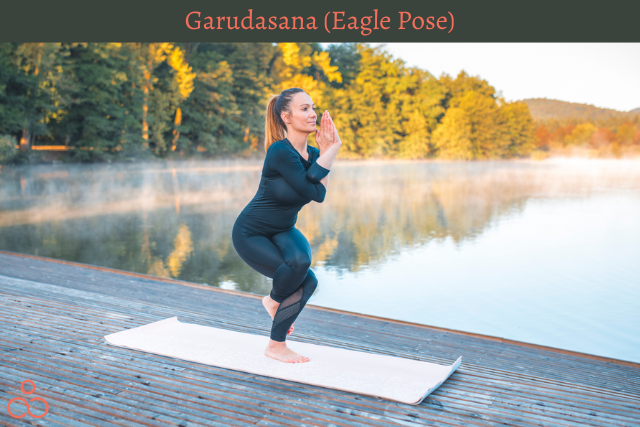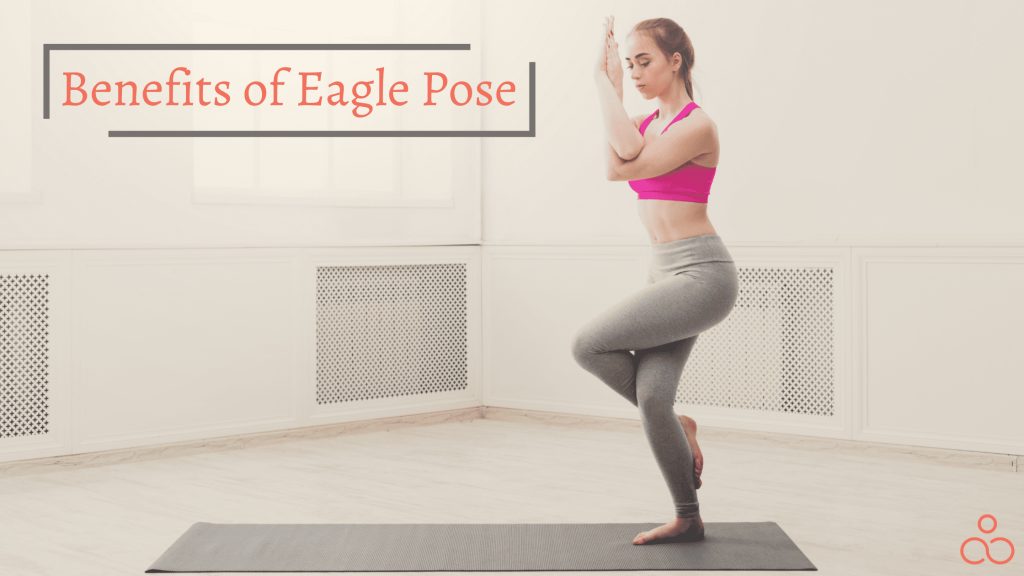Have you ever practiced Garudasana? This pose can help with both severe physical and emotional ailments. This pose is not only a very energetic workout but also has a significant positive impact on our health. The yoga position is renowned for its endurance, flexibility, and strength. As you go through the following sections, you will understand the meaning of the eagle pose, the steps to the eagle pose, modifications, and the benefits of eagle pose. So, let’s read on!
What is Garudasana or Eagle Pose?
The name garudasana is a combination of the Sanskrit words “garuda”, which means “a formidable bird of prey,” and “asana”, which means “yoga stance.” It is also the name of Lord Vishnu’s chariot (vahana), which is generally an eagle but can also be a hawk or a kite. Lord Vishnu travels the celestial planes on the back of the bird Garuda. Because it resembles a garuda or an eagle, this stance is known as “the eagle pose.” Verse 2.37 of the Gheranda Samhita describes it as having the hands on the knees and the legs and thighs on the ground. Additionally, B.K.S Iyengar and sritattvanidhi both discuss it in light of yoga.
It is a significant standing yoga posture that offers a wonderful stretch to the shoulders, upper back, and legs, as well as several other significant health advantages. The yoga position helps the body gain equilibrium and elegance. It is a standing balancing stance that centers your attention on the present. The eagle posture will give you a significant hip stretch, which opens up the back of the lungs and also tests your body awareness and mental focus.
Who can perform the Eagle Pose?
The eagle pose can be done by children, seniors, and people of all age groups alike. If you have any existing medical conditions then you must consult your medical practitioner before attempting the pose. If you have trouble standing or other balance concerns, you should alter this stance and further modify it to make it more comfortable for you. However, there are certain people who must avoid this pose completely as mentioned below:
- People having obesity issues
- People with ankle, shoulder, or knee injuries
- People with low or high blood pressure
- Pregnant Women
- People who have undergone recent surgeries
- People with anxiety issues
- People who are recovering from an existing health issue
How to do the Eagle Pose?

It is now time for detailed instructions on how to do the eagle position. We’ll go through both the practice and the preparation. This indicates the most effective ways to practice this position.
- As you inhale, sweep your arms out to the sides until they are parallel to the floor, starting in the different postures at the top of your yoga mat.
- Moving your arms forward as you exhale will cause them to cross in front of your torso, placing your right arm beneath your left. Make a careful attempt when you flex your elbows so that your hands’ backs meet. Alternatively, you might wrap your forearms and contact your palms. Make sure your forearms are drawn up and away from your body.
- When you exhale, you should bend your knees and then into the chair posture. You should truly ground into your left foot and direct your attention a few feet in front of you while you do this. As you get ready for the posture, this is a wonderful time to take a few deep breaths and center yourself.
- When you are ready, just lift your right leg over your left calf, letting your right toes rest on the yoga mat, a yoga block, or behind your left calf as you feel comfortable doing so. Squeeze your inner thighs together while you do this.
- Now that you’re sitting low in your chair, you may cross your right arm over your left, wrap your arms around each other until your palms contact, and then release. Alternatively, you can just take hold of your left fingers with your right hand, whatever feels most natural to you. Breathe into the backs of your shoulder blades while you align your knees and elbows in a straight line.
- Here, you may take a minute to relax and breathe. Just keep breathing deeply, and keep your attention focused on the point in front of you. You can drop your seat to the floor to get a greater hip stretch.
- Returning to the mountain pose will allow you to exit the position. To achieve this, just shake out your arms and legs as you stand back up at the top of the mat.
- It’s time to switch sides; you may now repeat the previous instructions while switching the arms and legs for the same number of breaths and duration. This yoga stance can even be performed twice: once as a warm-up and once more to simply deepen the pose.
Alterations for different people:
- Pregnancy: If you are pregnant, avoid bending your legs. Instead, take a deep breath and sit in the position to tone your quadriceps.
- Beginners: Work your way up to the full-balance position if you are just starting with the eagle stance. Until you feel secure, wrap your toes around the opposing calf.
- Advanced: Dip your knee in a downward-bent position for even greater difficulty. To hasten shoulder activation, raise your arms over your head.
- Weak Knees: Maintain a high torso if you have knee issues so that the pressure is dispersed equally throughout your body. Additionally, avoid bending your legs.
- Weak Back: By omitting the foot bend, you can lessen the strain on your lower back.
- Weak Shoulders: Keep your elbows positioned underneath your shoulders if your shoulders aren’t strong. Spread your bottom arm out wide or fully bend it if the position is still unpleasant.
- Tight Hips: Avoid crossing your legs and instead spread them out to the widest possible distance if you have tight hips.
Modifications to Eagle Pose:
- Lean your back against the wall and take support to provide the necessary rest to your leg.
- Some people won’t be able to wrap the elevated foot around the calf. If you fall into this category, put a block beneath your foot instead. You may also use your foot as a kickstand by resting it on the ground. This will help you maintain your balance.
- You might also wish to utilize a chair if you want to employ a new challenge or make it more difficult.
- You don’t anticipate or even expect to have an injury after your yoga workout. We consistently stress the importance of alignment for this reason. Your hands, thighs, and arms should all always be in line.
- One thing to keep in mind is that the advantages of this yoga practice will be reduced if you have a rounded back. Always be sure you perform it with a straight back.
15 Benefits of Eagle Pose
Garudasana is a yoga stance that has several health advantages, some of which are listed below:
- Restores balance and neuromuscular coordination in the body.
- Extends shoulders, thighs, upper back, and hips to make the body more flexible.
- Beneficial for both renal and prostate disorders.
- Fixes postural and structural issues.
- Alleviates shoulders’ toughness.
- Helps eliminate urinary issues.
- Increases your capacity for introspection by sharpening your attention.
- Strengthens the toe and foot ligaments and muscles
- Encourages organization and prevents damage between the shoulder blades.
- Helps in reducing the impact of asthma, sciatica, and lower backaches.
- Improves the ability to stay focused.
- Removes tightness in the calf of muscles
- Strengthens the calves, legs, and feet.
- Reduces immobility in the core muscles and promotes serenity.
- Helps loosen up the shoulders, arms, chest, and abdominal muscles.
The major impact of Eagle Pose on our body
Stimulates the immune system: When you do the position, your blood flow is restricted and you feel pressure comparable to that of a massage when you twist your legs and arms. The body may be stimulated and fresh blood can be released by using the massage effect. Improved circulation is essential for increasing immunity. Practice the eagle stance every day to gain its advantages and boost your immunity.
Aligns the chakras: Within the human body, the chakras are energy centers that extend from the base of the spine to the top of the head. One or more chakras are stimulated by each yoga pose. Due to the close contact with the floor and the emphasis on a specific place, the eagle pose opens the third eye chakra as well as the root chakra. Grounding is promoted by a balanced root chakra, while the focus is developed by the third eye energy point. When both chakras are in harmony, you become more focused and have a stronger sense of who you are.
Promotes balance: It can be challenging to find balance in both life and yoga. However, one may perfect the synchronization of the body, mind, and spirit through the eagle pose. You aim to balance both sides of your body by evenly practicing on both legs while you maintain a solid posture when performing the pose. Male and female energies are stored on the right and left sides of the body, respectively. The stance creates harmony between these two by constricting and unwinding both sides, giving balance and relaxation.
Stretches the shoulders and wrists: Regular practice of garudasana ensures flexible shoulders and wrists. Your wrists and shoulders receive the necessary stretch when you raise your arms and hands toward the sky, which helps to reduce the tightness and knots in these regions.
Strengthens the ankles: By paying attention to alignment, practitioners can benefit from the eagle pose’s strengthening effects on the ankles. The hamstrings, ankles, and hips were strengthened as you supported yourself on one leg while folding the other over it. Dig into the eagle pose, focus on the small things, and put your body, mind, and spirit in balance and alignment whenever you feel physically, mentally, or spiritually out of sync.
Conclusion
Overall, you should consider including the eagle posture in your regular yoga practice. It may aid in the development of your third eye chakra as well as help you focus better. You can modify the position to suit you if you get discomfort in your upper body when you cross your arms or if your shoulder blades are very tense. The eagle arms pose is a very adaptable yoga posture, therefore you should adjust it as you see fit to assist you to do this pose.

